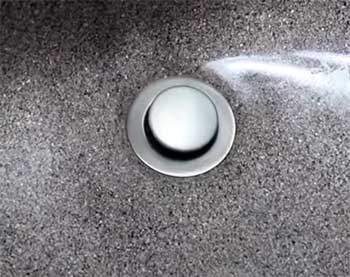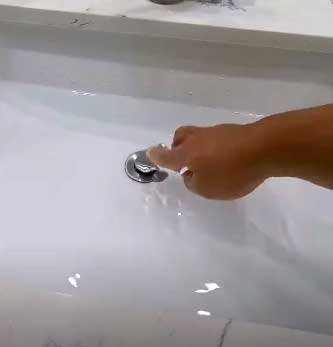The drain plug is one of the most critical parts of the drainage system of your house.
Whether for the sink or tub, you need to choose the right plug for your drain as nobody wants a clog or leak in their sink or tub. However, selecting the right one might be a little bit confusing.
Go through this pop-up drain vs. push-down drain analysis if you want to clear out all of your confusion regarding this issue.
A Quick Comparison Table
Here’s a quick comparison between the pop-up drain and push down drain –
| Specifications | Pop-up Drain | Push down Drain |
| Material | Chrome, Polished Brass, Antique Brass, Brushed Nickel, Venetian Bronze | Chrome, Bronze, Brushed Nickel |
| Price | Comparatively cheap | Costlier than Pop-up drain |
| Sink styles | Pedestal, Under-mount Vessel, Drop-in | Pedestal, Under-mount Vessel, Drop-in |
| Mechanism | Works with Lift and pivot rod | Works with spring |
| Designed option | Less | More |
| Unclogging | Easy to unclog | A bit complicated |
| Lever System | Yes | No |
Differences Between Pop-Up Vs. Push Down Drain
- Material

Pop-up drain and push-down drain both are made of solid metal.
However, the pop-up drain has more options in terms of the material it is made of.
They are created with materials such as Chrome, Polished Brass, Antique Brass, Brushed Nickel, Venetian Bronze, etc.
On the other hand, push-down drain only comes with three different materials – Chrome, Bronze, and Brushed Nickel.
So, if you’re looking for some varieties, the pop-up drain is for you.
- Price Differences
Pop-up drain is more common in the market, and its price is also less than push-down drain’s. The price of a lift rod pop-up drain with overflow usually starts at almost $75.88, and a pop-up drain without overflow costs nearly $70.34.
However, the price mostly depends on the metal that has been used for the making. You will find a chrome pop-up drain to cost less than the other options.
Push-down drain is considered a more modern option, and its price is comparatively higher than the pop-up drain. The advantage of a pushdown drain is that, with or without overflow, it costs the same.
A chrome push-down drain with or without overflow costs around $96.79, which is almost $26 higher than the chrome pop-up one.
- Sink Styles
Both the pop-up drain and push-down drain fit in different styles of sinks. Pedestal, Under-mount Vessel, Drop-in, etc. are the most common stylish sinks, and both kinds of drains go with these perfectly.
Though pop-up drain usually comes with pedestal sinks, you can also use this drain with any other type of sink.
- Mechanism
A pop-up drain’s mechanism is a little bit more complicated than that of a push-down drain. The pop-up simultaneously works with a lift rod, a pivot rod, and a lever. It follows the push and pulls method.
On the other hand, the push-down drain is really easy to use and the mechanism is also simple.

With one push, the spring inside the drain blocks the path and prevents the water from passing, and another push removes the block to pass the water.
- Design Options
Pop-up drain bathroom sink and tub come with slightly less designed options, whereas push down drain has plenty of designed and colored options.
So, if you want your bathroom sink and tub to be more aesthetic-looking and classy, you can go for a push-down drain.
- Unclogging
It is obvious that everyone wants a sink or tub that never gets clogged. Unclogging is such a hassle, and people want an easy solution for this.
As the pop-up drain operates with rods, it is easy to clean the hair or other waste from it.
Push-up drain works with spring, and hair gets tangled up with the spring quickly. Sometimes it gets a bit difficult to unclog the hair from the spring.
But once you learn the tricks to unclog this push-down drain easily, it won’t be a problem.
Overflow: Do We Need It?
When it is a matter of drain plug, the word ‘overflow’ automatically comes along. Whether it’s a pop-up drain or push-down drain, the question about overflow remains – “Do we actually need it?’’
Well, the answer can’t be just a yes or no. First, you have to understand what the overflows are used for. Overflow consists of a hole and a drain to reroute the excess water in the sink.
If anyone keeps the faucet running and the sink almost gets full with water, this overflow will stop the water from falling on the floor.
We don’t always need an overflow, but in case of emergency, it can be of great help. If your drain comes up with an overflow line, you should buy it with overflow.
It will give your sink or tub extra protection. However, your sink or tub will work perfectly with or without an overflow. So the addition of an overflow is not essential.
Pop-Up Vs. Push Down Drain: Pros and Cons
Now let’s examine the advantages and disadvantages of each drain type.
Pop-Up Drain Pros
- Hand free lift rod operation
- Tight water-tight seal from rubber gasket
- Adjust height to fit any sink
- Smooth open/close motion from spring assembly
- Easy installation
- Components are serviceable and replaceable
Pop-Up Drain Cons
- More parts mean higher likelihood of failure
- Lift rod takes getting used to and can be noisy
- More regular maintenance required
- Prone to hair clogs around pivot rod
Push Down Drain Pros
- Extremely simple operation
- Metal-to-metal seal resists leaks and drips
- No springs or moving parts to repair or replace
- Compact, low-profile style
- Lower cost on average
Push Down Drain Cons
- Requires manually pushing to open and close drain
- Fixed height doesn’t adjust to sink depth
- Rubber seal provides better water-tight closure
- No lever for hands-free operation
As you can see, there are convincing reasons to select either a pop-up or push down drain. The pros and cons come down to your priorities and the existing sink setup.
Pop-up Or Push Down?

Let’s first talk about pop-up drain for your better understanding. Pop-up drain plug consists of a lift rod, pivot rod, and lever.
When you pull the pop-up stopper, it pulls the lift rod as well as the pivot rod. Then it pops up and opens the drain to pass the water through the plug.
That is why it is called a pop-up drain. Again, when you need to block the drain, just push the pop-up stopper, and the drain will be sealed.
On the other hand, the technique push-down drain follows is less complicated than the pop-up drain. There is a spring inside the push-down drain plug, which does the main job.
When you push down the plug, the spring blocks the drain, and thereby, the water can’t pass through.
It needs another push to open up, and that’s why it is called push down drain. You might have also heard about sprung waste, click-clack, push-button; these three are exactly the same as a push-down drain.
After going through all the differences between the pop-up drain and push-down drain, you might ask, “Which one stands out?”
Actually, the answer pretty much depends on you. Because everyone has different choices and demands. Some might consider the price; some might consider the model before buying. So, decide your priority first.
Keeping the price aside, the push-down drain will be the best option for modern households. Because –
- Push down drain is easy to use. When used in the bathtub, it can operate with toe as well, and works similarly to toe touch drain stopper.
- Pop-up drain is considered backdated nowadays because of its mechanism. The lever of pop-up drain stands on the faucet, which some people do not like.
- Push down drain comes with different models and styles. It easily goes with stylish sinks and bathtubs.
- When push down drain is used in bathtubs, it gives ultimate comfort as the surface of its cap is plain and there’s no lever outside of the drain.
- Push down drain is also easy to install.
Pop-Up Vs. Push Down Drains: FAQ
Pop up drains are not necessarily better overall, but they do offer some advantages. Their adjustable height fits any sink depth, the lift rod allows hands-free operation, and the rubber gasket provides an airtight seal. However, regular push down drains are simpler, have fewer parts to break, and don’t require any maintenance.
A grid drain has a flat perforated cover rather than a plug style stopper. Water simply drains through the holes while debris is caught by the grid. Grid drains don’t seal closed. Pop up drains have a rubber stopper that seals the drain closed when not in use. The stopper lifts up via a rod mechanism to open the drain.
A push pop up drain functions like a standard push down drain but has the benefit of a pop up stopper rather than a fixed lid. Pushing down on the stopper opens the drain while releasing pressure allows the stopper to rise and seal closed again. The seal is created by a rubber gasket rather than metal-to-metal contact.
A pop up drain with overflow has an extra hole and gasket that allows excess water to drain if the sink overflows. This overflow hole is sealed by a second connected stopper mechanism. Pop up drains without overflow simply seal off the main drain hole but don’t provide any extra overflow capacity.
Final Words
There is endless debate on pop-up drain vs. push-down drain. Both drains are suitable for bathroom sinks or tubs compared to other types of drains. Choosing the right drain is such a big deal because we all want a leak-free drainage system that is also easy to use and install.
Push-down drain can always be the best option for your bathroom/ kitchen. But if you want to go for a relatively cheap option, pop-up drain is there for you.
Finally, whichever drain you are going to use, make sure that you clean the drain regularly.

what can i use to clean a smelly drain?